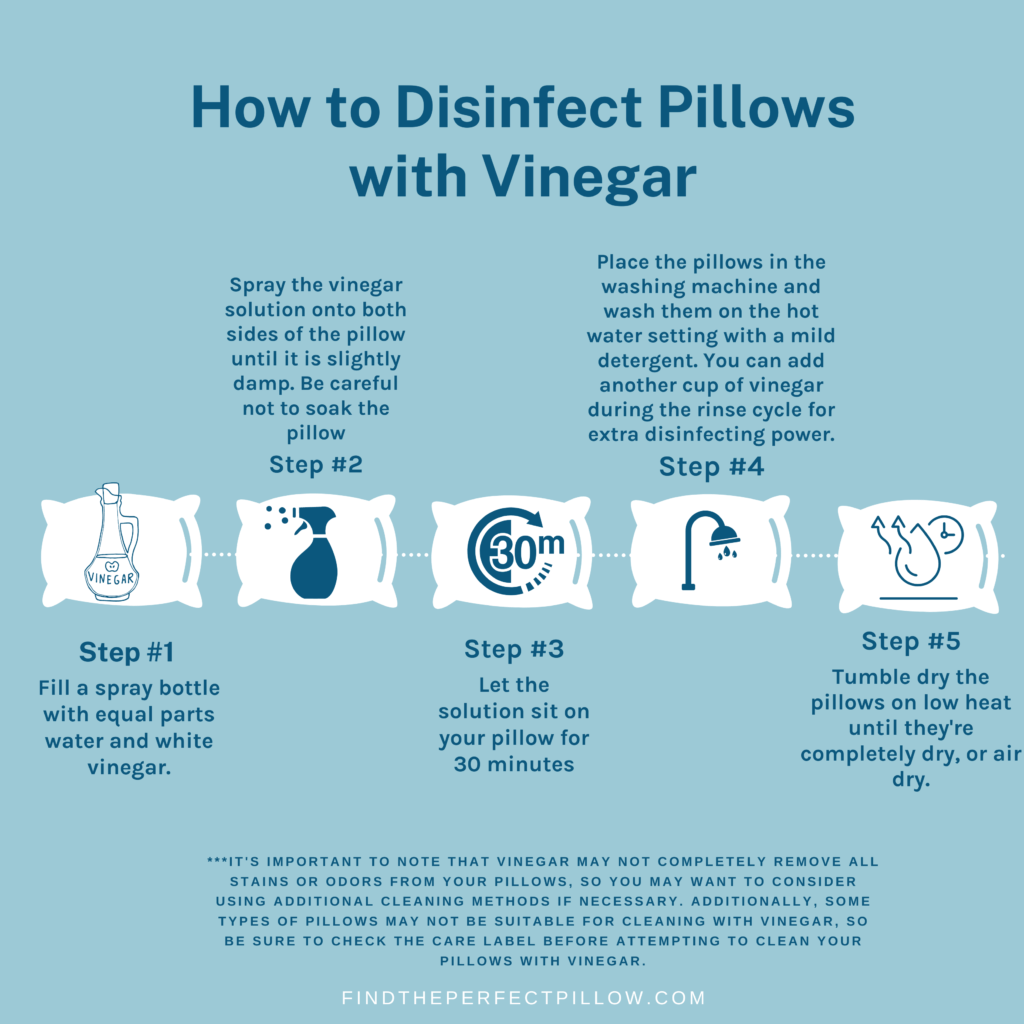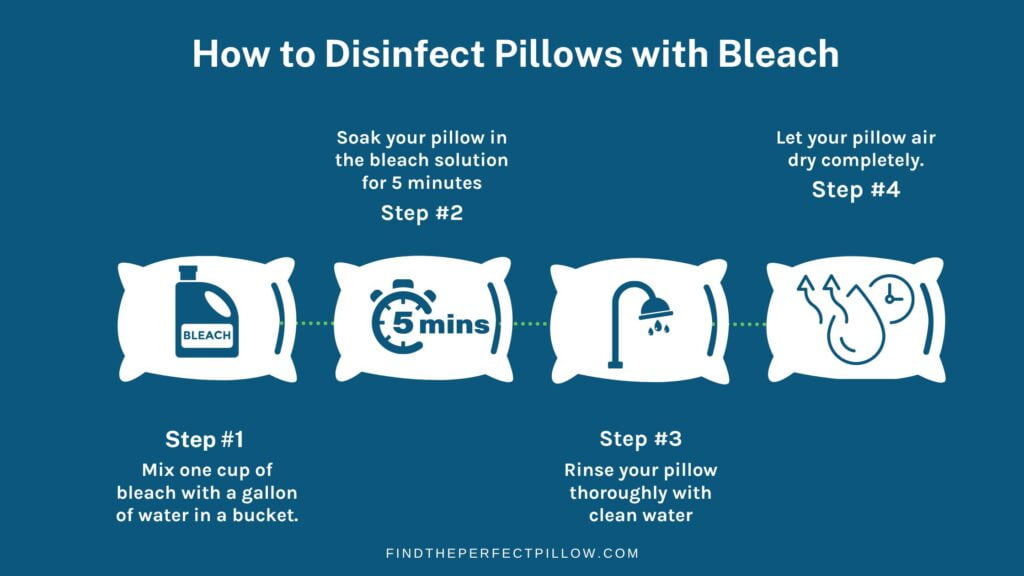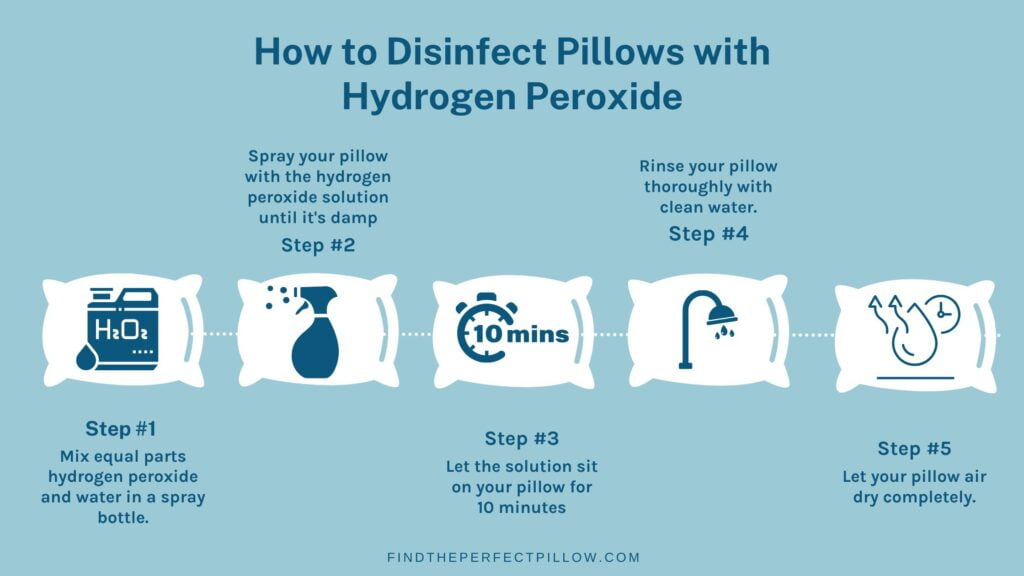Affiliate Disclosure Statement: Purchases made through our website, CarWashNearMe.org, may earn us a commission as an Amazon Affiliate and through other general affiliates. Our recommendations are based on unbiased research and expertise. No extra cost is incurred by you. We do not accept payment or compensation to influence our reviews or recommendations. For more information, please see our affiliate disclosure page. Thank you for trusting our unbiased expertise.
Pillows play an essential role in helping us get a good night’s sleep, but did you know that they can also be home to bacteria, viruses, and other pathogens? Especially in the midst of a pandemic, keeping your pillows disinfected is more important than ever. In this article, we’ll guide you through the different ways you can disinfect your pillows to keep them germ-free.
The Importance of Pillow Disinfecting
Pillows can harbor all kinds of germs, including bacteria, viruses, and fungi, that can cause health issues ranging from minor skin irritation to more serious respiratory problems. The best way to keep these pathogens at bay is through regular cleaning and disinfecting. Experts recommend disinfecting your pillows at least once every six months, or more frequently if someone in your household is sick.
How to Disinfect Pillows with Vinegar
Maintaining a clean and healthy sleeping environment is essential to ensure a good night’s sleep. Pillows are often a breeding ground for bacteria, allergens, and dust mites. That’s why disinfecting your pillows regularly is crucial, especially if you’re prone to allergies or have respiratory problems. But with so many disinfecting options available, it can be challenging to know which one is safe and effective.
One natural and affordable way to disinfect your pillows is with vinegar. Vinegar is a mild disinfectant that can effectively kill bacteria, viruses, and other germs on surfaces, including pillows. It’s also generally safe for use on most types of pillows, including those with down or feather fillings, as it is less likely to cause damage or discoloration compared to bleach or hydrogen peroxide.
Here’s how to disinfect your pillows with vinegar:
- Remove the pillowcases and any other coverings from your pillows.
- Fill a spray bottle with equal parts water and white vinegar.
- Spray the vinegar solution onto both sides of the pillow until it is slightly damp. Be careful not to soak the pillow.
- Allow the vinegar solution to sit on the pillow for at least 30 minutes.
- After 30 minutes, place the pillows in the washing machine and wash them on the hot water setting with a mild detergent. You can add another cup of vinegar during the rinse cycle for extra disinfecting power.
- Once the wash cycle is complete, tumble dry the pillows on low heat until they’re completely dry. You can add a couple of clean tennis balls to help fluff them up. Alternatively, you can leave the pillows in a well-ventilated area to air dry completely.
It’s important to dilute the vinegar properly and follow the recommended soaking time to ensure effective disinfection without damaging the pillow. After disinfecting, rinse and dry your pillow thoroughly to remove any remaining vinegar and prevent damage or discoloration.
However, vinegar may not completely remove all stains or odors from your pillows, so you may want to consider using additional cleaning methods if necessary. Additionally, some types of pillows may not be suitable for cleaning with vinegar, so be sure to check the care label before attempting to clean your pillows with vinegar.
Disinfecting your pillows with vinegar is an easy and natural way to maintain a clean and healthy sleeping environment. By following these simple steps, you can effectively kill germs and bacteria while keeping your pillows in good condition.
How to Disinfect Pillows with Bleach
If you’re looking for a powerful disinfectant to use on your pillows, bleach can effectively kill bacteria, viruses, and other germs on surfaces. However, it’s important to note that not all pillows are suitable for disinfection with bleach.
Some pillows may be damaged or discolored by bleach, and certain types of fillings, such as down or feathers, may be too delicate to withstand bleach treatment. Before using bleach to disinfect a pillow, it’s essential to read the care label and any instructions provided by the manufacturer to determine if bleach is safe to use and what concentration to use.
If your pillow is safe to use with bleach, here’s how to disinfect it:
- Mix one cup of bleach with a gallon of water in a bucket.
- Soak your pillow in the bleach solution for 5 minutes.
- Rinse your pillow thoroughly with clean water.
- Let your pillow air dry completely.
It’s crucial to dilute the bleach properly and follow the recommended soaking time to ensure effective disinfection without damaging the pillow. After disinfecting, rinse and dry your pillow thoroughly to remove any remaining bleach and prevent damage or discoloration.
Remember, not all pillows can be disinfected with bleach. Be sure to check the care label on your pillow to make sure it’s safe to use bleach on it. If bleach is not an option, consider using vinegar or hydrogen peroxide as a natural and safe alternative.
In conclusion, disinfecting your pillows regularly is important to maintain a clean and healthy sleeping environment. By following these tips, you can effectively kill germs and bacteria while keeping your pillows in good condition.
How to Disinfect Pillows with Hydrogen Peroxide
If you’re looking for a safe and effective way to disinfect your pillows, hydrogen peroxide is a mild disinfectant that can effectively kill bacteria, viruses, and other germs on surfaces, including pillows. Hydrogen peroxide is generally safe for use on most types of pillows, including those with down or feather fillings, as it is less likely to cause damage or discoloration compared to bleach.
Before using hydrogen peroxide to disinfect a pillow, it’s important to read the care label and any instructions provided by the manufacturer to ensure that it is safe to use and what concentration to use. When using hydrogen peroxide to disinfect a pillow, it’s important to dilute it properly and follow the recommended soaking time to ensure effective disinfection without damaging the pillow.
If your pillow is safe to use with hydrogen peroxide, here’s how to disinfect it:
- Mix equal parts hydrogen peroxide and water in a spray bottle.
- Spray your pillow with the hydrogen peroxide solution until it’s damp.
- Let the solution sit on your pillow for 10 minutes.
- Rinse your pillow thoroughly with clean water.
- Let your pillow air dry completely.
It’s crucial to dilute the hydrogen peroxide properly and follow the recommended soaking time to ensure effective disinfection without damaging the pillow. After disinfecting, rinse and dry your pillow thoroughly to remove any remaining hydrogen peroxide and prevent damage or discoloration.
Remember, not all pillows can be disinfected with hydrogen peroxide. Be sure to check the care label on your pillow to make sure it’s safe to use hydrogen peroxide on it. If hydrogen peroxide is not an option, consider using vinegar or bleach as an alternative.
Disinfecting your pillows regularly is important to maintain a clean and healthy sleeping environment. By following these tips, you can effectively kill germs and bacteria while keeping your pillows in good condition.
Disinfecting Pillows: Bleach vs Hydrogen Peroxide – Which Method is Best?
Both bleach and hydrogen peroxide can be effective in disinfecting pillows, but it’s important to use them properly and follow the instructions on the label.
Bleach is a strong disinfectant that can kill a wide range of bacteria, viruses, and other pathogens. However, it can also be harsh on some materials and may cause discoloration or damage if not diluted properly. Additionally, bleach has a strong odor that some people may find unpleasant.
Hydrogen peroxide is also an effective disinfectant that can kill bacteria and viruses. It is generally considered to be safer and less harsh on materials than bleach. However, like bleach, it can cause discoloration or damage to some materials, so it’s important to follow the instructions carefully.
Ultimately, the best method for disinfecting your pillows depends on the type of pillow you have and your personal preference. Before using any disinfectant, it’s important to check the care instructions for your specific pillow type and follow them accordingly. If you’re unsure, it’s always a good idea to consult with a professional cleaner or the manufacturer for guidance.
Other Ways to Disinfect Your Pillows Safely
If you’re looking for an alternative to bleach or hydrogen peroxide, there are other ways to disinfect your pillows safely. Here are some options:
- Use a UV-C light wand to kill germs on the surface of your pillow.
- Wash your pillows in hot water and a disinfecting laundry detergent.
- Use a steam cleaner to disinfect your pillows without using any chemicals.
Tips for Maintaining a Clean and Sanitized Sleep Environment
In addition to disinfecting your pillows, there are other steps you can take to keep your sleep environment clean and germ-free. Here are some tips:
- Wash your sheets and pillowcases regularly in hot water.
- Vacuum your mattress and pillows to remove dust and allergens.
- Use a hypoallergenic pillow cover to protect your pillow from germs and allergens.
- Wash your hands regularly, especially before touching your face or your pillows.
Conclusion
In conclusion, keeping your pillows disinfected is an important step in maintaining a clean and healthy sleep environment. Whether you choose to use bleach, hydrogen peroxide, or another disinfectant, be sure to follow the manufacturer’s instructions carefully and take appropriate safety precautions. Remember that disinfecting your pillows should be done periodically, but not too often as it can damage the pillows’ material and reduce their lifespan.
Additionally, it’s essential to maintain good pillow hygiene by regularly washing your pillow covers, fluffing your pillows to maintain their shape, and replacing your pillows every one to two years or as needed.
By following these tips and guidelines, you can ensure that your pillows are free of harmful pathogens and allergens, allowing you to have a restful and healthy night’s sleep. Remember, a clean and comfortable sleep environment is key to waking up refreshed and ready to take on the day.
Join Our Community
Don’t miss out on our latest tips and articles about finding the perfect pillow for your needs! Subscribe to our newsletter today and stay up-to-date with the latest news in pillow technology, pillow care, and more. Join our community of pillow enthusiasts and discover the key to a better night’s sleep.


